
Being intent on a major battle in the vicinity of Leipzig, the Allies resolved, on 13 October, to send forward an offensive grand reconnaissance. Baron von Toll, a Russian staff officer attached to the headquarters of the Army of Bohemia, sent a note to Wittgenstein, who commanded the Russian 1st and 2nd Corps, at 3:15 p.m. to inform him that the advance would begin the next day.
Murat, commanding the French forces south of Leipzig, fearing he would be overrun by the large force of the allies, proposed to Napoleon that he be allowed to withdraw to the far
side of the Partha. Napoleon sent Imperial Aide-de-Camp General Gourgaud [see feature article: Napoleon Conquers Time and Distance in Napoleon #1 for a detailed analysis on Napoleon's staff system] to advise Marshal Murat that he was arriving in Leipzig on the 14th. Murat, commanding the forces retreating from the Dresden front, felt reassured by this promise and decided to accept battle against the pursuing Army of Bohemia.
Unfortunately, Murat chose to abandon his position by Crobern and Gulden-Gossa, and withdrew towards Leipzig during the night of 13/14 October. During the morning of the 14th, his forces were deployed as follows:
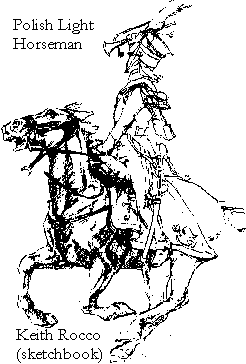
Wittgenstein ordered a pursuit of the French.
However, the pursuers were admonished to do so
"without getting entangled in an unequal battle."
Wittgenstein had, on his side, organized his troops in two columns. The left column had Pahlen's cavalry corps in the lead, and moved on Magdeborn with the Soum, Grodno, and Loubny Hussar Regiments, three cossack regiments under Illowaiski XII and Russian Horse Battery #7. Ten Prussian squadrons from the Neumark Dragoons, the East Prussian Cuirassiers, and the Silesian Uhlan Regiment, supported by Prussian Horse Battery #10 came next.
Behind them was the Reserve Cavalry Brigade of General Roder consisting of the Silesian and Brandenburg Cuirassiers, the 2nd Silesian Hussars, the 7th and 8th Silesian Landwehr Cavalry, and two Prussian horse batteries.
General Pahlen occupied the bank of the Goselbach with General Helfreich's 14th Russian Division and bivouacked the cavalry in groups on the southern bank of the stream. Pahlen got Wittgenstein's order to advance against Stormthal at 5:00 a.m. Similar orders were sent to Klenau, commanding the Austrian 4th Armeeabteilung, but they were not received until around 9:30 a.m. These orders required the pushing forward of the Russian advanced guard posts, to ascertain the presence or departure of the French from their positions. Because a thick fog covered the ground, it was not until about 8:00 a.m., as the French advanced troops drew back, that the Allies ascertained with certainty that the French had vacated their positions by Stormthal, Gulden-Gossa and Crobern.
Wittgenstein ordered a pursuit of the French. However, the pursuers were admonished to do so "without getting entangled in an unequal battle." Pahlen, with the reinforced advanced guard, moved towards Stormthal, where the day before the French main body was presumed to be. He did so by moving "in front" of the French through Magdeborn (Tanzberg) Gulden-Gossa. Helfreich's 14th Division, with the Radjanov #2, Jaroslav and Illowaiski #12 Cossack Regiments screening its advance, moved through Crobern.
General Klenau sent a short order:
"The French retire, they must therefore
be struck on all sides."
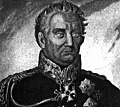 Behind the mass of cavalry came Helfreich's 14th Infantry Division, which marched on Crobern; the 4th Infantry Division (Pischnitzky), which moved on Gulden-Gossa; the 5th Infantry Division (Mezentzov), which moved against Stormthal; and finally General von Kleist's 2nd Prussian Corps.
Behind the mass of cavalry came Helfreich's 14th Infantry Division, which marched on Crobern; the 4th Infantry Division (Pischnitzky), which moved on Gulden-Gossa; the 5th Infantry Division (Mezentzov), which moved against Stormthal; and finally General von Kleist's 2nd Prussian Corps.
As a reserve, Gorchakov, commanding the 1st Russian Corps, held back the 3rd Division from Wurttemberg's 2nd Russian Corps. Kleist's 2nd Corps was also held back, with Kleist supervising the Prussian 9th and 12th Brigades. They passed through Gulden-Gossa, followed by General Ziethen with the Prussian 10th and 11th Brigades. The Prussian light cavalry moved through Stormthal.
General Klenau sent a short order: "The French retire, they must therefore be struck on all sides." Later, General Pahlen, supported by the Prussian reserve cavalry and the Russian 3rd Cuirassier Division, followed Helfreich's 14th Division to Crobern. The right hand column, formed by Klenau's men, moved out of the University Forest to seize Liebertwolkwitz.
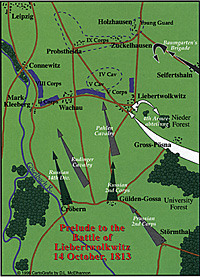 Pahlen advanced. The Russian Grodno, Loubny, and Soum Hussar Regiments, plus Russian Horse Battery #7, departed their bivouacs along the Goselbach at 8:30 a.m., and began moving
through Gulden-Gossa. The attached Prussian cavalry, with their horse battery, received orders to follow them and began movement in the same direction at 9:00 a.m. Pahlen had, at this
time, arrived on the heights south of Gulden-Gossa.
Pahlen advanced. The Russian Grodno, Loubny, and Soum Hussar Regiments, plus Russian Horse Battery #7, departed their bivouacs along the Goselbach at 8:30 a.m., and began moving
through Gulden-Gossa. The attached Prussian cavalry, with their horse battery, received orders to follow them and began movement in the same direction at 9:00 a.m. Pahlen had, at this
time, arrived on the heights south of Gulden-Gossa.
The Illowaiski #12 Cossacks encountered, and signaled to him, the presence of a large French force supported by 30 guns near Mark-Kleeberg. Pahlen stopped his movement and detached one of his brigade commanders, General Rudinger, with the Grodno Hussars to support the Illowaiski #12 Cossacks.
Pahlen then sent the Grodno Hussars towards Mark-Kleeberg, and the Loubny Hussars towards Liebertwolkwitz, to reconnoiter, while he rode with the Soum Hussars and the Russian horse battery towards the heights north of Gulden-Gossa. Once there, he awaited the arrival of the Prussian cavalry. The Loubny Hussars soon reported a large French force stood there as well, convincing Pahlen of the numerical superiority of the French standing before him. He decided it would be prudent to wait for the arrival of the Prussian cavalry before resuming his advance. He was joined by Diebitsch, a Prussian staff officer attached to Army headquarters, who wanted him to fall immediately on the French. However, Pahlen refused to move before the arrival of the Prussian Cavalry Reserve and Duka's 3rd Russian Cuirassier Division. When they did arrive, he sent forward the Soum Hussars, Russian Horse Battery #7 and the Prussian Neumark Dragoon Regiment. As Pahlen maneuvered his cavalry, Prince Eugene of Wurttemberg brought his 2nd Russian Corps to a position north of Gulden-Gossa.
"The enemy will withdraw as soon as
we fire a few cannon shots..."
Wurttemberg was, at this time, marching his corps through Magdeborn towards Gulden-Gossa under the cover of a hussar squadron posted on the heights north of Gulden-Gossa. The hussars were to warn him of any threatening French movements. Shortly later he was taken under fire by a group of French cavalry. Behind the French hussars, a French general and his retinue galloped from the north, to the heights overlooking Wurttemberg's advance. Wurttemberg then moved to the south of Gulden-Gossa, to join Pahlen and Diebitsch. He informed them he had found strong French forces on the Wachau Liebertwolkwitz line, and that his corps would not be able to advance through Gulden-Gossa without becoming embroiled in an unequal battle. Diebitsch did not believe the French would resist such a move seriously. As he rode through Magdeborn, Prussian staff officer von Hake had told him, "The enemy will withdraw, as soon as we fire a few cannon shots," so he obviously doubted any serious French resistance.
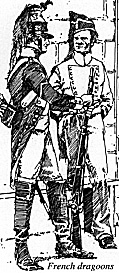 Wurttemberg and Diebitsch joined with Pahlen's advanced guard, as Diebitsch observed the French cavalry marching from the heights north of Gulden-Gossa. Now even Diebitsch realized that a major battle was about to occur.
Wurttemberg and Diebitsch joined with Pahlen's advanced guard, as Diebitsch observed the French cavalry marching from the heights north of Gulden-Gossa. Now even Diebitsch realized that a major battle was about to occur.
About the same time, shortly before 9:00 a.m., Gorchakov's advance guard reached Stormthal. His column contained the Grekov #8 Cossack Regiment and Tchougouiev Uhlan Regiment. It was later joined by six Prussian squadrons. They advanced through Stormthal, and would become embroiled in the whirling cavalry battle.
Helfreich's 14th Division and the two Prussian battalions under Oberstleutnant Lobel had reached Crobern. General Rudinger advised Pahlen that the French were reinforcing their forces between MarkKleeberg and Wachau. Pahlen sent him nine squadrons of landwehr cavalry, which took position without being observed by the French. His cossacks and landwehr cavalry, later supported by the Grodno Hussar Regiment, skirmished east of Crostewitz, with the Polish cavalry standing between MarkKleeberg and Wachau. They held the ground until the arrival of the 3rd Russian Cuirassier Division.
Russian Horse Battery #7 moved forward to a position
on the northern rim of the plateau by Gulden-Gossa
and began to fire on the French cavalry. P>
Pahlen moved the Soum Hussar Regiment to the plateau north of Gulden-Gossa. The Prussian cavalry was in the order in which it had departed its bivouacs that morning. First came the Neumark Dragoon Regiment, then two squadrons of the Silesian Uhlan Regiment, the East Prussian Cuirassier Regiment, and Horse Battery #9. Both east of Wachau and by Liebertwolkwitz, there were posted a number of French batteries, which flanked and began firing on the Russian hussars, marching between the villages on the height.
Russian Horse Battery #7 moved forward to a position on the northern rim of the plateau by Gulden-Gossa and began to fire on the French cavalry. It was supported by the Soum Hussars. Its target was formed in a deep column. The French regiments were formed in columns of divisions along the eastern side of the Erlen Woods. The battery began to put howitzer shells into the thick mass of French cavalry.
 Murat, who had held his cavalry on the Galgenberg (translated as "Gallows Hill") behind Wachau, noted that the Russian horse battery was very exposed, and sent forward some of Pajol's regiments to stop this battery from tormenting them. The battery was only supported by the Soum Hussars, who were thrown back. The battery itself quickly withdrew to a position by the Prussian artillery. The French cavalry was then taken in the flank by the Neumark Dragoon Regiment. Their attack was followed by an attack by the East Prussian Cuirassiers, in a platoon column, and the Silesian Cuirassiers.
Murat, who had held his cavalry on the Galgenberg (translated as "Gallows Hill") behind Wachau, noted that the Russian horse battery was very exposed, and sent forward some of Pajol's regiments to stop this battery from tormenting them. The battery was only supported by the Soum Hussars, who were thrown back. The battery itself quickly withdrew to a position by the Prussian artillery. The French cavalry was then taken in the flank by the Neumark Dragoon Regiment. Their attack was followed by an attack by the East Prussian Cuirassiers, in a platoon column, and the Silesian Cuirassiers.
At the same time, the two squadrons of Silesian Uhlans swung to the left, and struck the rear echelons of the French. The attack was too much for the French cavalry, who withdrew rapidly.
General von Roder, with his reserve cavalry, and the landwehr cavalry, under the command of Colonel von Mutius, passed through Crobern, and as they passed through the defile, they found the cossacks and hussars engaged against overwhelming forces. The Prussian cavalry deployed as they advanced out of the village. The Brandenburg Cuirassier Regiment and Prussian Horse Battery #2 moved to the north of Crobern.
The Grekov #8 Cossacks and the Tchougouiev Uhlan Regiment arrived on the battlefield at that time. The Silesian and Brandenburg Cuirassiers took up positions to the left of the East Prussian Cuirassiers, while the Neumark Dragoons and Soum Hussars rallied and formed the second line.
Roder sent the landwehr cavalry, under von Mutius, to support the cossacks north of Crobern, and placed himself with the Silesian Cuirassier Regiment and Prussian Horse Battery #2. He ordered them to advance at a trot, and ordered the Brandenburg Cuirassiers to follow behind quickly. As he reached the the Leipzig Road, he saw on the plateau a mass of French cavalry to the north. The Silesian Cuirassier Regiment was ordered forward to attack them.
The Brandenburg and Silesian Cuirassiers deployed to the left in platoon column and trotted forward on Pahlen's left. The Silesian Cuirassiers deployed to the left and the Brandenburg Cuirassiers deployed to the right, both in echelons. They advanced forward on either side of the East Prussian Cuirassier Regiment. The three regiments drove forward and struck the head of General Milhaud's 6th Heavy Cavalry Division, the 22nd and 25th Dragoons, who had formed in line. Behind the 22nd and 25th Dragoons came a column formed of the 20th, l9th and 18th Dragoon Regiments.
The battle continued, in an uninterrupted series of charges and countercharges. Murat forgot his duty as an army commander by once again reducing himself to the position of brigade or regimental commander and leading one charge after another. He lost overall control of the battle.
Towards noon, the exhaustion of both sides was so great that, for a short while, the two belligerent forces on the plateau by Gulden-Gossa stood 300 to 400 paces from one another, resting their tired horses and recovering their wounded. The further course of the battle consisted of uncoordinated rushes of small groups of cavalry without overall direction.
In one instance, Murat had personally led forward a regiment. It broke in the attack and was falling back when Lieutenant Guido von der Lippe, of the Neumark Dragoon Regiment, spotted Murat virtually undefended. He promptly led forward a small force of men, in an effort to seize the French Marshal, but was killed by an aide accompanying Murat [see "Two Interpretations of Murat's Near-Capture"].
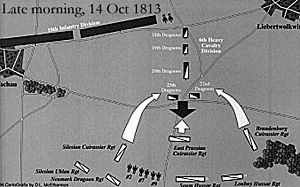 Pahlen, seeing the size of the French force opposing him, resolved to hold his position until the arrival of Klenau's Austrian column. He refused his left wing and supported it with two Prussian batteries. He pushed forward his right wing. The French, on their side, reinforced their right and established, between Wachau and Liebertwolkwitz, a number of strong batteries, whose fire took the allied left in enfilade.
Pahlen, seeing the size of the French force opposing him, resolved to hold his position until the arrival of Klenau's Austrian column. He refused his left wing and supported it with two Prussian batteries. He pushed forward his right wing. The French, on their side, reinforced their right and established, between Wachau and Liebertwolkwitz, a number of strong batteries, whose fire took the allied left in enfilade.
Murat, believing the moment had come to finish the allied force, formed the cavalry of the V Cavalry Corps and threw them against the allied batteries. The allied artillery responded with cannister that inflicted many casualties on the leading French regiments. The Russian Hussars, the Prussian Uhlans and the Brandenburg Cuirassiers took advantage of this to throw themselves on the French. It was now 2:00 p.m.
Battle of Liebertwolkwitz: Order of Battle
Back to Editor's Note for Prelude to Leipzig
Back to Table of Contents -- Napoleon #4
© Copyright 1996 by Emperor's Press.
This article appears in MagWeb (Magazine Web) on the Internet World Wide Web.
The full text and graphics from other military history magazines and gaming magazines are available at http://www.magweb.com